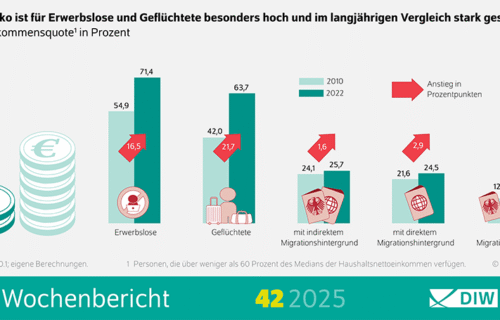Germany’s long-running prosperity narrative continues to conceal deep divisions. According to updated research from the German Institute for Economic Research (DIW Berlin) based on the Socio-Economic Panel (SOEP), the overall risk of poverty has barely changed since 2020, holding steady at around 17 percent of the population. Yet among refugees and the unemployed, the rates remain three to four times higher — a structural imbalance that economic growth alone has failed to resolve.
“It is clear that work protects against poverty,” said DIW economist Markus M. Grabka, who leads the annual evaluation of wage and income data. “But integration into the labour market and a fair transfer system are essential. As it stands, increases in working hours have little effect on the wallets of those in the lower income bracket.”
The DIW findings show that while hourly wage inequality has narrowed in recent years—thanks in part to the minimum wage and improved pay in eastern Germany—the real purchasing power of households has eroded under the weight of high inflation in 2021–2022. Statistisches Bundesamt confirmed that real incomes fell for the first time in nearly a decade, a setback that hit low-income groups hardest.
The share of people facing financial insecurity has stagnated since the pandemic period. Among those without a migration background, the poverty risk remains below 13 percent, but for people with a migration background, it hovers around a quarter of the population. For refugees, the picture is starker. The IAB-BAMF-SOEP Refugee Survey, which tracks their economic situation, estimates that as many as 60 percent of refugee households live below the poverty threshold — an improvement from earlier years, yet still alarmingly high.
“The good news is that since 2020, the poverty risk among refugees has fallen slightly, which is likely due to increasing labour market integration,” Grabka told DIW Berlin’s Distribution Report.
Experts note that the income gap in Germany is not widening further but remains “stuck” at a high level. Studies from DIW Berlin and Destatis suggest that stagnant wage mobility, part-time work, and limited access to full employment continue to trap many households at the lower end of the income scale.
The data reveal what analysts describe as a “two-speed” Germany: a stable middle-income majority and a growing minority struggling with rising costs, insecure jobs, and limited prospects for advancement. DIW Berlin concludes that stronger policies to promote full-time employment and reform the benefits system could help translate economic growth into real income gains for all.
“Germany’s economy is still growing, but not everyone feels the benefit,” Grabka warned. “Reducing inequality and poverty will require more than a good labour market—it demands structural change.”
Source: DIW Berlin
